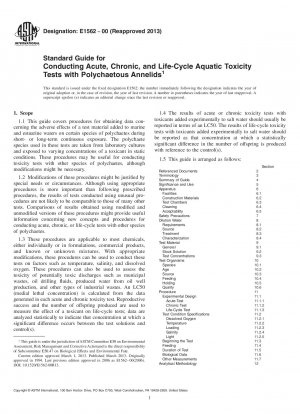ASTM E1562-00(2013)
Standard Guide for Conducting Acute, Chronic, and Life-Cycle Aquatic Toxicity Tests with Polychaetous Annelids
- Standard No.
- ASTM E1562-00(2013)
- Release Date
- 2000
- Published By
- American Society for Testing and Materials (ASTM)
- Status
- Replace By
- ASTM E1562-22
- Latest
- ASTM E1562-22
- Scope
5.1 Polychaetes are an important component of the benthic community, in which they generally comprise 30 to 508201;% of the macroinvertebrate population. They are preyed upon by many species of fish, birds, and larger invertebrate species. Larger polychaetes feed on small invertebrates, larval stages of invertebrates, and algae. Polychaetes are especially sensitive to inorganic toxicants and, to a lesser extent, to organic toxicants (1).3 The ecological importance of polychaetes and their wide geographical distribution, ability to be cultured in the laboratory, and sensitivity to contaminants make them appropriate acute and chronic toxicity test organisms. Their short life cycle enables the investigator to measure the effect of contaminants on reproduction.
5.2 An acute toxicity or chronic text is conducted to obtain information concerning the immediate effects of an exposure to a test material on a test organism under specified experimental conditions. An acute toxicity test provides data on the short-term effects, which are useful for comparisons to other species but do not provide information on delayed effects. Chronic toxicity tests provide data on long-term effects.
5.3 A life-cycle toxicity test is conducted to determine the effects of the test material on survival, growth, and reproduction of the test species. Additional sublethal endpoints (for example, biochemical, physiological, and histopathological) may be used to determine the health of the species under field conditions.
5.4 The results of acute, chronic, and life-cycle toxicity tests can be used to predict effects likely to occur on marine organisms under field conditions.
5.5 The results of acute, chronic, or life-cycle toxicity tests might be used to compare the sensitivities of different species and the toxicities of different test materials, as well as to study the effects of various environmental factors on the results of such tests.
5.6 The results of acute, chronic, or life-cycle toxicity tests might be an important consideration when assessing the hazards of materials to marine organisms (see Guide E1023) or when deriving water quality criteria for aquatic organisms (2).
5.7 The results of acute, chronic, or life-cycle toxicity tests might be useful for studying the biological availability of, and structure activity relationships between, test materials.
5.8 The results of acute, chronic, and life-cycle toxicity tests will depend partly on the temperature, quality of food, condition of test organisms, test procedures, and other factors.
1.1 This guide covers procedures for obtaining data concerning the adverse effects of a test material added to marine and estuarine waters on certain species of polychaetes during short- or long-term continuous exposure. The polychaete species used in these tests are taken from laboratory cultu......
ASTM E1562-00(2013) Referenced Document
- ASTM E1023 Standard Guide for Assessing the Hazard of a Material to Aquatic Organisms and Their Uses
- ASTM E729 Standard Guide for Conducting Acute Toxicity Tests on Test Materials with Fishes, Macroinvertebrates, and Amphibians
- ASTM E943 Standard Terminology Relating to Biological Effects and Environmental Fate
- IEEE/ASTM SI 10 American National Standard for Metric Practice
ASTM E1562-00(2013) history
- 2022 ASTM E1562-22 Standard Guide for Conducting Acute, Chronic, and Life-Cycle Aquatic Toxicity Tests with Polychaetous Annelids
- 2000 ASTM E1562-00(2013) Standard Guide for Conducting Acute, Chronic, and Life-Cycle Aquatic Toxicity Tests with Polychaetous Annelids
- 2006 ASTM E1562-00(2006) Standard Guide for Conducting Acute, Chronic, and Life-Cycle Aquatic Toxicity Tests with Polychaetous Annelids
- 2000 ASTM E1562-00 Standard Guide for Conducting Acute, Chronic, and Life-Cycle Aquatic Toxicity Tests with Polychaetous Annelids

Copyright ©2024 All Rights Reserved